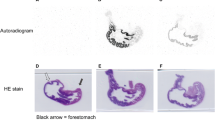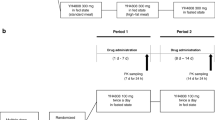Summary
The anticholinergic compound Acabel (the benzilic acid ester of N,N-dimethyl-2-hydroxy-methyl-piperidinium-methyl sulphate), tritium labelled in the piperidine molecule, was administered to 6 healthy voltunteers. Its absorption was measured by comparing the radioactivity in gastrointestinal aspirates with that of an unabsorbed marker. The main uptake of Acabel was localized in the upper part of the small intestine, and amounted to 10–20% of the given dose. — Studiesin vitro showed that3H-Acabel can be metabolized in the small intestine. However,in vivo there was no evidence of its decomposition while the test solution was passing through the proximal part of the digestive tract.
Similar content being viewed by others
References
Beckmann, R.: Zum Verhalten von Benzilsäure-(N,N-dimethylhydroxy-methyl-piperidinum)-ester-methyl-sulfat im Organismus. Arzneimittelforschung16, 910–918 (1966).
Beermann, B., Hellström, K., Rosén, A.: The gastrointestinal absorption of3H-atropine in man. Clin. Sci.40, 95–106 (1971 A).
-- -- -- The gastrointestinal absorption of anticholinergic drugs. Comparison between individuals. Acta pharmacol. In press (1971 B).
Bray, G.B.: A simple efficient liquid scintillator for counting aqueous solutions in liquid scintillation counter. Anal. Biochem.1, 279–285 (1960).
Engstedt, L., Johansson, S., Nyberg, A.: Estimation of human erythrocyte life-span from bilirubin turnover. J. Lab. clin. Med.70, 195–203 (1967).
Hellström, K., Rosén, A., Söderlund, K.: The gastrointestinal absorption and the excretion of H3-butylscopolamine (hyoscine butylbromide) in man. Scand. J. Gastroent.5, 585–592 (1970).
Hydén, S.: A turbidimetric method for the determination of higher polyethylene glycols in biological materials. Kungl. Lantbrukshögskolans Annaler22, 139–145 (1955).
Levine, R.M., Blair, M.R., Clark, B.B.: Factors influencing intestinal absorption of certain monoquaternary anticholinergic compounds with special reference to bezomethamine, J. Pharmacol. exp. Ther.114, 78–86 (1955).
Nosslin, B.: The direct diazo reaction of bile pigment in serum. Scand. J. clin. Lab. Invest.12, 1–176 (1960).
Osterloh, G., Lagler, F., Staemmler, M., Hehn, F.: Pharmakologische und toxikologische Untersuchungen über Benzil-Säure-(N,N-dimethyl-2-hydroxy-methyl-piperidinium)-ester-methyl-sulfat, ein neues Spasmolyticum. Arzneimittelforschung16, 901–910 (1966).
Schöniger, W.: Eine mikroanalytische Schnellbestimmung von Halogen in organischen Substanzen. Mikrochim. Acta1, 123–129 (1955).
Author information
Authors and Affiliations
Rights and permissions
About this article
Cite this article
Beermann, B., Hellström, K. & Rosén, A. Uptake in the human small intestine of a quaternary anticholinergic compound (Acabel). Eur J Clin Pharmacol 3, 93–96 (1971). https://doi.org/10.1007/BF00619300
Received:
Accepted:
Issue Date:
DOI: https://doi.org/10.1007/BF00619300




